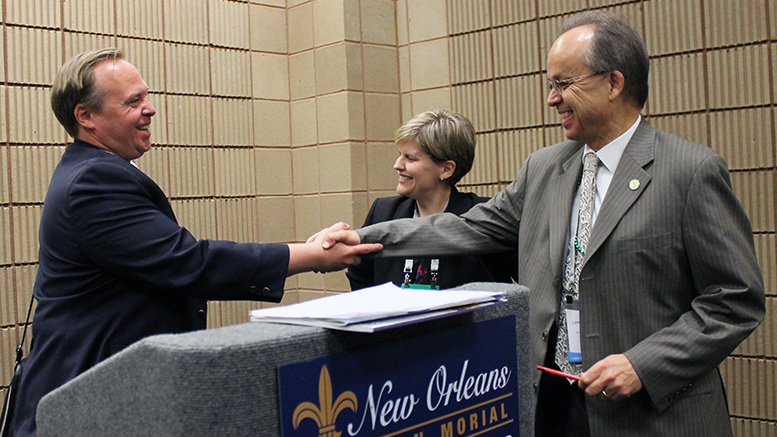NEW ORLEANS – Community colleges in New Jersey and Michigan successfully reformed their policies on developmental education placement, and as a result, are seeing fewer students in remedial courses and higher completion rates.
College leaders from those states offered their perspectives on developmental education at a session earlier this week at the annual convention of the American Association of Community Colleges (AACC).
The moderator, Lawrence Nespoli, president of the New Jersey Council of County Colleges, reiterated the goals presented in AACC’s 2012 report, Reclaiming the American Dream: The only way for community colleges to increase the completion rate by 50 percent by 2020 is to double the number of students who complete development education and reduce the number who need remediation.
Placement tests dropped
Both New Jersey and Michigan are decentralized states, where community colleges have a great deal of autonomy and flexibility compared to states with more highly structured regulation of community colleges. Being in a decentralized state allows for more innovation, said Erica Lee Orians, executive director of the Michigan Center for Student Success at the Michigan Community College Association.
“But when you want things to happen statewide, coordination is difficult,” she added.
Having that kind of autonomy in New Jersey enabled Warren County Community College (WCCC) to eliminate placement testing, said President William Austin, a member of the AACC board of directors.
After dropping placement testing, the college’s graduation rate went from about 20 percent to 40 percent, Austin said. In the past, a student placed into a developmental class at WCCC had just a 7 percent chance of eventually graduating. Among students who were in remedial classes in both English and math, no one graduated.
Austin believes students will succeed, even if they are not considered college ready, if they are taught “fortitude and grit.”
There was a lot of pushback from the faculty, he acknowledged. The pass rate for an English composition course dropped to 50 percent, but when he went through every transcript, he found the only students who failed were the ones who had been in remedial classes.
New approaches
At Northwestern Michigan College (NMC), the number of students in remedial English “dropped dramatically” after the college started using a multifactor placement system – considering high school grades and SAT scores – rather than a single test, said President Timothy Nelson.
Nelson found students had been performing poorly on English placement tests because most writing in high school was fictional writing, and students didn’t know how to write research papers.
Students are now in mixed classes for English, where they work in teams combining students who need remediation and those who are considered college ready.
In math, Nelson said, NMC dropped the notion that everyone should be on an algebra/calculus track. Now, students who don’t need those courses take math courses that are better tied to their career goals.
If students had a hard time with math in high school, it doesn’t make sense to have them take the same course in college and expect them to do better, he said.
Orians agreed that everyone doesn’t need to be on calculus track. For English, she recommends co-requisite remediation, in which students take a support course and college-level course at the same time.
“Stop using high-stakes placement tests.” Orians said. “It does not work. It’s the lowest predictor of success.”
In Michigan, use of the state’s Merit Exam and high school GPAs have had the best rate of successfully predicting how well students would do in college, she said. The Compass placement test had the lowest success rate.
Colleges still need to serve students who are very underprepared, Orians said. But now they can devote more resources to them, rather than have to serve 60 to 70 percent of the population in remediation.
Nespoli believes it’s better to encourage students to give it a shot, rather than telling them they’re not ready for college.
A member of the audience noted that “when a student fails a developmental education course, they blame the college for putting them in there. If they fail a college-level course, they blame themselves.”
Readiness redefined
Colleges need to do a better job of communicating to high schools exactly what being ready for college means, Orians said.
“We’re going into this with the assumption that everyone needs to be tested, but some students are exempt. What we should say is you are college-ready if you get certain grades and SAT scores,” she said, then only those students who aren’t at that level should be tested.
Thanks in part to the Michigan Transfer Agreement, in which four-year institutions recognize general education credits from community colleges, Orians said, 52 percent of the people who earn a bachelor’s degree had attended a community college.
“We’re doing this wrong,” said Austin, “We’re letting four-year schools treat us like we’re treating high schools.”
He urged community colleges to sell themselves to the four-year institutions, noting that the four-year colleges have enrollment problems, too.
“Teach your students to be good consumers,” he said. Rutgers University offered one of his top students a scholarship and said “it would take the student’s credits but not count them.” He encouraged the student to accept instead a full ride, including room and board, from a less-prestigious college in Alabama.
Words of wisdom
Nespoli asked the panelists for a single piece of advice to help more college students get to the finish line. Nelson said he would tell students: “Don’t just meet with an advisor; create a relationship with someone who is a guide, who understands the system.”
Orian suggested beginning every meeting and conversation with, “How does this impact students?”
“Believe and trust in the student,” Austin advised. Most are poor, don’t have enough food and are working two jobs. How many people could survive that and still try to go to college? “They are tough; they can do it.”

